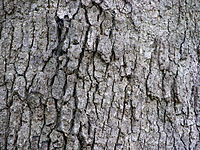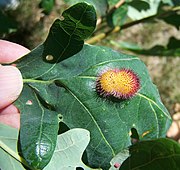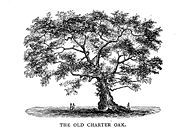Quercus alba
| White Oak | ||||||||||||||||
|---|---|---|---|---|---|---|---|---|---|---|---|---|---|---|---|---|
 | ||||||||||||||||
| Conservation status | ||||||||||||||||
| Scientific classification | ||||||||||||||||
| ||||||||||||||||
| Binomial name | ||||||||||||||||
| Quercus alba L. |
The tree species Quercus alba is also called "white oak". It is a long-lived oak in the family Fagaceae, native to eastern North America, from southern Quebec west to eastern Minnesota, and south to northern Florida and eastern Texas. Specimens are known to have lived over 600 years.
Although called the white oak it is very unusual to find an individual with white bark; the usual color is an ashen gray. In the forest it reaches a magnificent height. In the open it develops into a massive broad-topped tree with great limbs striking out at wide angles.Description
Normally not a very tall tree, typically 65-85ft tall at maturity, it nonetheless becomes quite massive and its lower branches are apt to reach far out laterally parallel to the ground. The tallest known white oak is 144ft tall. It is not unusual for a white oak tree to be as wide as it is tall. Conversely, specimens at high altitude may only be small shrubs. White oaks have been known to live over five hundred years. The bark is a light ash-gray and somewhat peeling, variously from the top, bottom and/or sides.
In spring the young leaves are exquisite in their delicate silvery pink, covered with soft down as with a blanket. The petioles are short, and the leaves which cluster close to the ends of the shoots are pale green and downy with the result that the entire tree has a misty, frosty look which is very beautiful. This lovely vision continues for several days passing through the opalescent changes of soft pink, silvery white and finally yellow green.
The leaves grow to 5-8.5 in long and 2.75-4.5 in broad, with a deep glossy green upper surface turning reddish brown in autumn; some brown leaves may remain on the tree throughout winter until very early spring. They are variably lobed; sometimes the lobes are shallow, extending less than half-way to the midrib, but sometimes they are deeply lobed, with the lobes somewhat branching. The acorns are usually sessile, and grow to .5-1 in long, falling in early October.
It is sometimes confused with the Swamp white oak, a closely-related species, and the Bur oak. The White oak hybridizes freely with the Bur oak, the Post oak, and the Chestnut oak.
- Bark: Light gray, varying to dark gray and to white; shallow fissured and scaly. Branchlets at first bright green, later reddish-green and finally light gray. A very distinguishing feature of this tree is that a little over half way up the tree the bark tends to become platy, that is that it looks sort of like overlapping scales that are easy to see and make this tree easy to identify.
- Wood: Light brown with paler sapwood; strong, tough, heavy, fine-grained, durable and beautiful. Sp. gr., 0.7470; weight of cu. ft., 46.35 lbs.
- Winter buds: Reddish brown, obtuse, one-eighth of an inch long.
- Leaves: Alternate, five to nine inches long, three to four inches wide. Obovate or oblong, seven to nine-lobed, usually seven-lobed with rounded lobes and rounded sinuses; lobes destitute of brisltes; sinuses sometimes deep, sometimes shallow. On young trees the leaves are often repand. They come out of the bud conduplicate, bright red above, pale below and covered with white tomentum; the red faded quickly and they become silvery greenish white and shining; when full grown are thin, bright yellow green, shining or dull above, pale, glaucous or smooth below; midrib stout, yellow, primary veins conspicuous. In late autumn they turn a deep red and drop, or on young trees remain on the branches throughout the winter. Petioles short, stout, grooved, and flattened. Stipules linear, caducous.
- Flowers: May, when leaves are one-third grown. Staminate flowers borne in hairy aments two and a half to three inches lone; calyx bright yellow, hairy, six to eight-lobed, lobes shorter than the stamens; anthers yellow. Pistillate flowers borne on short peduncles; involucral scales hairy, reddish; calyx lobes acute; stigmas bright red.
- Acorns: Annual, sessile or stalked; nut ovoid or oblong, round at the apex, light brown, shining, three-quarters to an inch long; cup cup-shaped, encloses about one-fourth of the nut, tomentose on the outside, tuberculate at base, scales with short obtuse tips becoming smaller and thinner toward the rim.
Distribution
The White oak is fairly tolerant of a variety of habitats, and may be found on ridges, in valleys, and in between, and in dry and moist habitats, and in moderately acid and alkaline soils. It is mainly a lowland tree, but reaches altitudes of 5,249ft in the Appalachian Mountains.
Cultivation
The White Oak makes an outstanding shade tree, with an exceptionally wide spread and almost never dropping limbs. However, it does not tolerate urban conditions well, due to an intolerance of soil compaction and changes in soil levels. It may thrive in residential neighborhoods where protected from such change.
Uses
Its wood is the best and most valuable of the white oaks, although wood of most of the other white oaks may be marketed with it. White oak is relatively rot resistant. It was a signature wood used in mission oak furniture by Gustav Stickley in the Craftsman style in the Arts and Crafts movement. White Oak's have cellular structures called tyloses. Tyloses give the wood a closed cellular structure, which does not allow water to pass. Tyloses are cell ingrowths of living wood parenchyma into the cavities of xylem conducting cells. The white oaks, with tyloses, are used in making wine and whiskey barrels as well as outdoor furniture. Red Oaks do not have the tyloses, thus white oak barrels are used in wine and whiskey production to prevent leaking, which would be the result of using red oaks. It has been used for construction, shipbuilding, cooperage, agricultural implements, and interior finish of houses.
White oak is used extensively in Japanese martial arts for some weapons such as bokken and jo. It is valued for its density, strength, resiliency and relatively low chance of splintering if broken by an impact, relative to the substantially cheaper red oak. Urban legend attributes Japanese White Oak (“Kashi”) as the choice wood but, by law, no white oak is harvested in Japan. Virtually all white oak used in the manufacture of weapons in Japan is imported from North Western United States.
The acorns are much less bitter than the acorns of red oaks. They are small relative to most oaks, but are a valuable wildlife food, notably for turkeys, wood ducks, pheasants, grackles, jays, nuthatches, thrushes, woodpeckers, rabbits, squirrels and deer. They were also used by Native Americans as a food. The white oak is the only known foodplant of Bucculatrix luteella and Bucculatrix ochrisuffusa caterpillars.
The USS Constitution is made from white oak, and reconstructive wood replacement comes from a special grove of Quercus alba known as "Constitution Grove".
Woodworkers should beware that ferrous metal hardware reacts with oak, causing corrosion and staining the wood. Brass fittings should be used instead.
Symbolism
White Oak has served as the official state tree of Illinois since being selected by a vote of school children. There are two "official" White Oaks serving as state trees, one located on the grounds of the governor's mansion, and the other in a schoolyard in the town of Rochelle. The white oak is also the state tree of Connecticut and Maryland. The Wye Oak, probably the oldest living white oak until it was felled by a thunderstorm on June 6, 2002, was the honorary state tree of Maryland.
One of the most famous White Oaks in America is the Charter Oak of Hartford, Connecticut, the subject of a legend nearly as old as the colony itself. The tree now makes up the reverse side of the Connecticut state quarter.





No comments:
Post a Comment